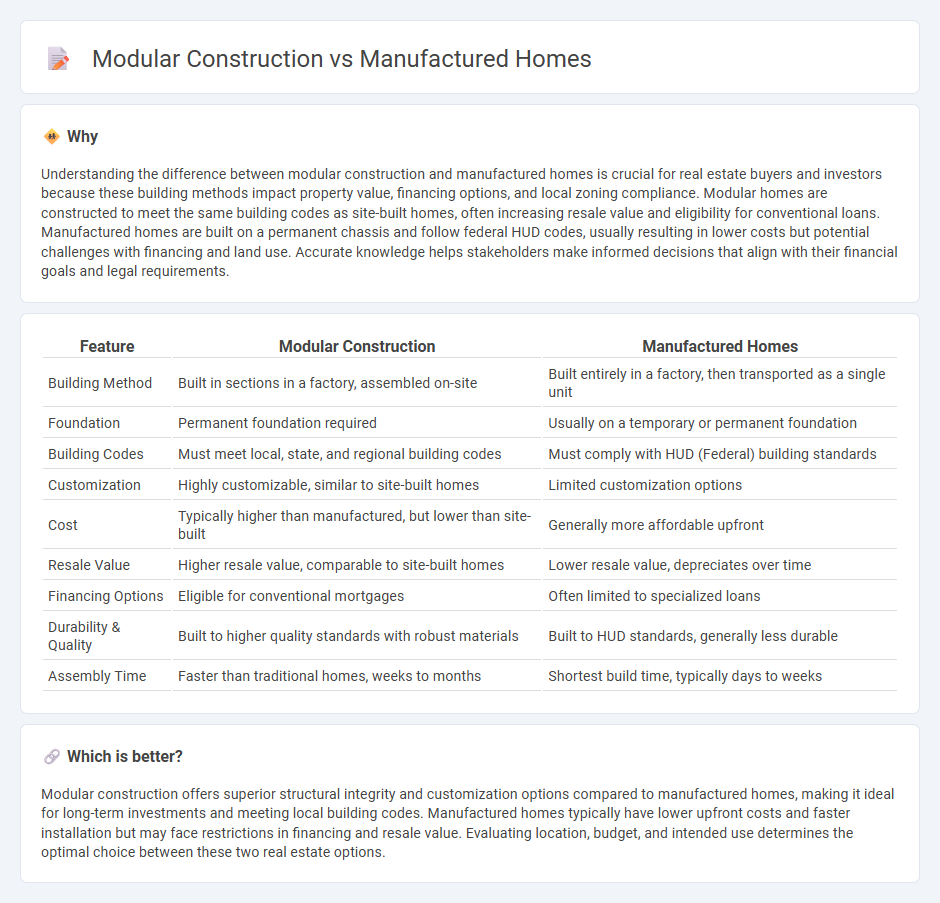
Modular construction involves building sections of a home in a factory setting before assembling them on-site, offering high quality and customization with faster completion times. Manufactured homes, built entirely in factories and transported to their permanent location, provide affordable housing options with regulated standards for safety and durability. Explore the key differences, benefits, and suitability of each method to determine the best choice for your real estate investment.
Why it is important
Understanding the difference between modular construction and manufactured homes is crucial for real estate buyers and investors because these building methods impact property value, financing options, and local zoning compliance. Modular homes are constructed to meet the same building codes as site-built homes, often increasing resale value and eligibility for conventional loans. Manufactured homes are built on a permanent chassis and follow federal HUD codes, usually resulting in lower costs but potential challenges with financing and land use. Accurate knowledge helps stakeholders make informed decisions that align with their financial goals and legal requirements.
Comparison Table
| Feature | Modular Construction | Manufactured Homes |
|---|---|---|
| Building Method | Built in sections in a factory, assembled on-site | Built entirely in a factory, then transported as a single unit |
| Foundation | Permanent foundation required | Usually on a temporary or permanent foundation |
| Building Codes | Must meet local, state, and regional building codes | Must comply with HUD (Federal) building standards |
| Customization | Highly customizable, similar to site-built homes | Limited customization options |
| Cost | Typically higher than manufactured, but lower than site-built | Generally more affordable upfront |
| Resale Value | Higher resale value, comparable to site-built homes | Lower resale value, depreciates over time |
| Financing Options | Eligible for conventional mortgages | Often limited to specialized loans |
| Durability & Quality | Built to higher quality standards with robust materials | Built to HUD standards, generally less durable |
| Assembly Time | Faster than traditional homes, weeks to months | Shortest build time, typically days to weeks |
Which is better?
Modular construction offers superior structural integrity and customization options compared to manufactured homes, making it ideal for long-term investments and meeting local building codes. Manufactured homes typically have lower upfront costs and faster installation but may face restrictions in financing and resale value. Evaluating location, budget, and intended use determines the optimal choice between these two real estate options.
Connection
Modular construction and manufactured homes both utilize factory-built components to streamline the building process, offering cost-efficient and time-saving alternatives to traditional site-built homes. These methods ensure high-quality production standards and reduce material waste through controlled environments, enhancing sustainability in real estate development. The growing acceptance of modular and manufactured homes is reshaping housing markets by providing affordable, customizable, and quick-to-deploy residential solutions.
Key Terms
Building Codes
Manufactured homes adhere to the HUD Code, a federal standard ensuring consistent safety and construction quality nationwide, whereas modular construction must comply with state and local building codes, often matching those of site-built homes. These differing regulations impact design flexibility, construction processes, and long-term value for homeowners. Explore further to understand how building codes influence your choice between manufactured and modular homes.
Permanence of Foundation
Manufactured homes are typically placed on temporary or semi-permanent foundations, which can affect their long-term stability and resale value compared to modular homes that are built on permanent foundations similar to traditional site-built houses. Modular construction involves assembling sections of a home in a factory setting, then permanently installing them on a concrete foundation, ensuring greater structural integrity and adherence to local building codes. Discover more about the distinct foundation requirements and benefits of both manufactured and modular homes to make an informed housing choice.
Assembly Location
Manufactured homes are built entirely in a factory and transported to the site fully assembled, allowing for rapid installation but limited customization options. Modular construction involves assembling individual modules on-site, offering greater flexibility in design and easier compliance with local building codes. Explore the differences in assembly location to determine which construction method suits your project needs best.
Source and External Links
Modular Homes & PreFab Homes In Cleveland, Ohio - Modular homes are factory-built with quality inspections, designed to be strong and protected from weather, allowing faster completion and healthier living environments compared to traditional site-built homes.
Modular Homes in Cleveland, Ohio | ModularHomes.com - Manufactured homes including park models and tiny homes are available in Cleveland, with financing options and local retailers to guide the home buying process.
Cleveland, Ohio Manufactured Homes for Sale | OMHA - Top quality factory-built manufactured and modular homes are offered throughout Ohio, providing affordable housing options with various styles and budgets.
 dowidth.com
dowidth.com